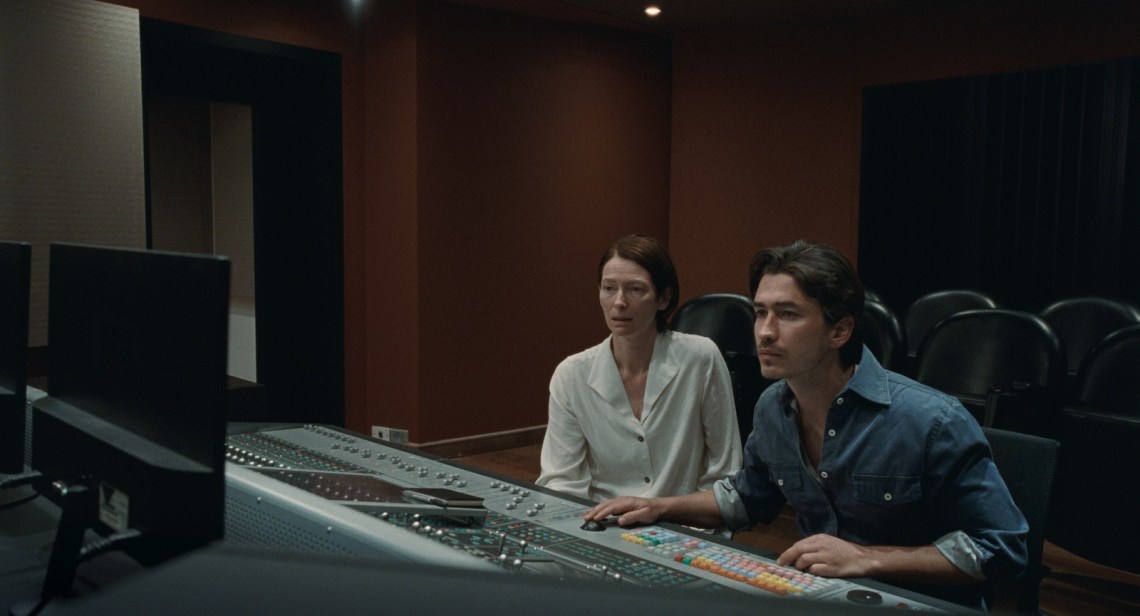A sudden bang erupts in the opening moments of Memoria, as if volleyed from the edge of a dream. It rouses Jessica (Tilda Swinton), a Scottish orchidologist far from home and suffering the insomniac’s usual fog: night drips into day and hallucinations leak into waking life. Like the ghosts and monsters that the filmmaker Apichatpong Weerasethakul has previously lured from the forests of his native northeastern Thailand, the sound in Memoria, his latest feature, is both spectral and terrestrial. At times it seems a phantom audible only to Jessica; at others, an emanation from the landscape. As we drift through central Colombia, from Bogotá to the rural village of Pijao, the mystery of the sound’s origin gives way to that of its course: how it moves through Jessica and moves her through more than just this world.
That opening bang is an offscreen sound, cleaved from any visible source. The search for its cause, though, involves not just the ear but all its fellow senses. “What was that sound?” is another way of asking: What do I know about the material world and how it behaves? Memoria’s sound design nudges prosaic scraps of ambient noise into the spotlight: a chair’s metallic shriek as it scrapes across the floor; blaring car alarms in a dark parking lot; the percussive drone of unrelenting rain. A backfiring bus becomes the crux of an early scene when Jessica watches, in broad daylight, as a man hears the blast and flings himself to the ground at a busy crossing. When he clocks the explosion’s pedestrian source, he leaps into a sprint anyway, as though the false echo of a violent noise is as true as its memory. The camera stays with Jessica’s bewilderment, her face furrowed as if in recognition of another life unraveled by the troubling gap between hearing something and knowing what you really heard.
In pursuit of her own apocryphal sound, Jessica meets with a young sound engineer, Hernán (Juan Pablo Urrego), at his studio in a university’s music department. This is the first time she attempts to describe that early-morning bang; the need to give it a tangible form is also a need to share it in language. Hernán’s English is as shaky as Jessica’s Spanish, but he’s committed and attentive, building off her stilted approximations: “It’s like…a big ball of concrete falling into a metal well…surrounded by seawater.” She resorts to gestures, too, her hands sculpting the air to limn the ball’s size and movement, though each sound he plays in response to her prompts is slightly amiss. Finally, one articulation steers close: “It’s like a rumble from the core of the earth.” Hernán pulls up a folder of Foley effects—postproduction sounds made to mimic real-world noises—and imports a track, its frequency displayed onscreen as a multicolored waveform. “Look at this mountain,” he says, dragging his cursor and clipping its peak to round off the sound. Stunned by the near-perfect recreation, Jessica has no words.
The irony, of course, is that we have already heard this impossible sound and will have heard it over and over by the film’s close, no clumsy verbiage or gesticulation needed to conjure it. In an interview at last year’s New York Film Festival, Apichatpong told the novelist Katie Kitamura that the film’s soundscape was an “integration of the audience and Jessica,” the kind of shared listening that cinema makes possible. Like Jessica in Hernán’s studio, we are tasked with reassembling a memory—listening becomes a search, or a way of testing cause and effect. What might make a sound like this, and how might we seize its particular textures? We leave the studio with a collaged Foley track, traces of real, recorded sounds clipped and distended in the service of an unreal one.
It might be tempting to read the sound in Memoria as a metaphor in the narrowest sense—a scaled-up analogy or a cipher promising hidden meaning—but I prefer the poet Mary Ruefle’s definition: “If metaphor is not idle comparison, but an exchange of energy, an event, then it unites the world by its very premise—that things connect and exchange energy.” Over twenty years of multimedia work, Apichatpong has made people, places, and sometimes even the frame that holds them permeable to such exchanges. No surprise that the longest-standing motifs in his films are sleep and convalescence, two states that pry open the body’s borders. Since his clash with junta-imposed censorship following the 2006 military coup in Thailand, Apichatpong has mobilized both these motifs toward more pointed criticisms of state politics. In Uncle Boonmee Who Can Recall His Past Lives (2010), kidney failure becomes karmic retribution for a former soldier’s killings. Sleep itself is the sickness when, in Cemetery of Splendor (2015), two ancient kings and their warring phantoms cast a group of unsuspecting soldiers into narcolepsy.





